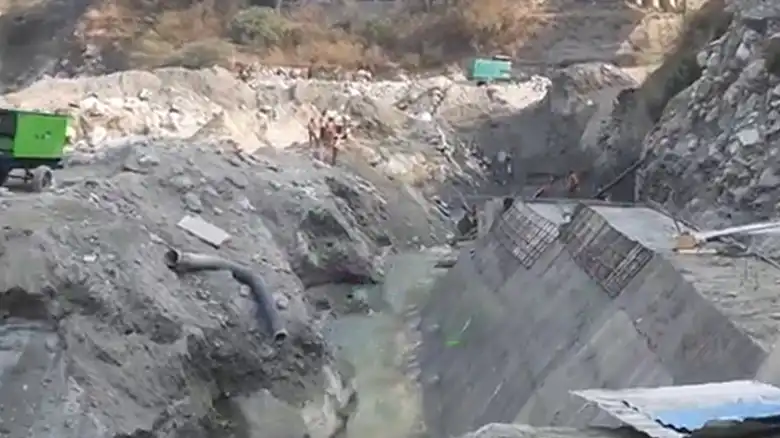A retaining wall is a vertical structure that is used to hold back earth or other materials. In the case of a river bank, a retaining wall is used to prevent erosion from undermining the bank and causing it to collapse. Retaining walls can also be used to create level ground on a sloping river bank, which can make it more usable for recreation or development.
In this article, I’ll walk you through the steps I take to build a sturdy, effective retaining wall along a river beside my property.

Building a Retaining Wall on a River Bank
Planning and Design
The first step in building a retaining wall on a river bank is to plan and design the wall. The size and type of wall will depend on the height of the bank, the type of soil, and the amount of water that the wall will be exposed to.
Materials
The most common materials used to build retaining walls on river banks are concrete, stone, and wood. Concrete walls are the most durable and can withstand the most severe weather conditions. Stone walls are also very durable, but they can be more expensive to build. Wood walls are the least expensive option, but they are not as durable as concrete or stone walls.
Excavation and Leveling
The construction process begins with the crucial step of preparing the site. Clear the designated area of any unwanted vegetation, debris, or existing structures. The goal is to create a clean slate for the retaining wall construction. Excavate the soil to establish a leveled foundation for the wall. Pay careful attention to achieving a proper slope to facilitate effective drainage away from the structure.
Installation of Footings
Once the site is prepared, dig trenches for the footings of the retaining wall. It’s essential to ensure that these footings are below the frost line to prevent any damage during freezing temperatures. Properly compact the soil within the trenches before pouring concrete, as this enhances the stability of the footings, providing a solid foundation for the entire structure.
Laying the First Course
With the footings in place, commence laying the first course of blocks or stones. Use a level to ensure that the blocks are evenly aligned and maintain the necessary angle to counteract the pressure exerted by the river bank. The first course is critical for establishing a stable base for the entire retaining wall.
Building the Wall
Continue the construction by stacking additional blocks or stones, ensuring that the joints are staggered for added strength. As you build upward, consider incorporating drainage pipes behind the wall to redirect water flow and prevent the accumulation of hydrostatic pressure. This step is crucial for ensuring the long-term stability of the retaining wall.
Backfilling
Once the wall is built to the desired height, proceed with backfilling. Fill the space behind the wall with gravel or crushed stone, which aids in proper drainage. Periodically compact the backfill material to prevent settling, ensuring the structural integrity of the retaining wall over time.
Finishing Touches
To give the retaining wall a polished appearance and protect its upper edge, add capstones or coping stones. These finishing touches not only contribute to the aesthetic appeal but also serve a functional purpose by preventing dislodgment of the top layer. Securely fix the capstones in place to ensure they provide lasting protection.
Maintenance and Inspection of Your Retaining Wall
Regular visual inspections are vital post-construction to identify signs of wear and tear, including small cracks that may escalate into significant structural problems over time. Examine the surface for bulging or bowing, indicating pressure from the soil behind the wall, and promptly address these deformities to maintain stability.
Inspect the riverbank side for erosion signs such as soil washouts or exposed roots. Swiftly addressing these issues protects the wall’s foundation and extends its lifespan. Ensure the drainage system functions correctly, promptly addressing any clogs or malfunctions to prevent water buildup and excess pressure on the wall.
During inspections, promptly address minor issues like cracks by sealing them to prevent water infiltration. Add compacted backfill to mitigate erosion problems. Conduct seasonal inspections, especially before heavy rain, to identify and promptly address weaknesses exacerbated by increased water flow.
Manage vegetation regularly, checking for growth around and on the wall, and promptly removing plants or trees, especially tree roots, that may exert significant strain. Regularly inspect the drainage system, ensuring it remains debris-free and functions properly to prevent hydrostatic pressure.
Additional Tips
It is important to consult with a professional engineer before building a retaining wall on a river bank. The engineer can help you to design a wall that is the right size and type for your needs.
It is also important to obtain the necessary permits before building a retaining wall on a river bank. In some cases, you may need to obtain a permit from the local government or the state or federal government.
If you are not comfortable building a retaining wall yourself, you can hire a professional contractor. Professional contractors have the experience and expertise to build a wall that is safe and durable.
Sum Up
Building a retaining wall on a river bank can be a challenging task, but it is also a rewarding one. By following the steps in this guide, you can build a wall that will protect your property from erosion and create level ground that can be used for recreation or development.
